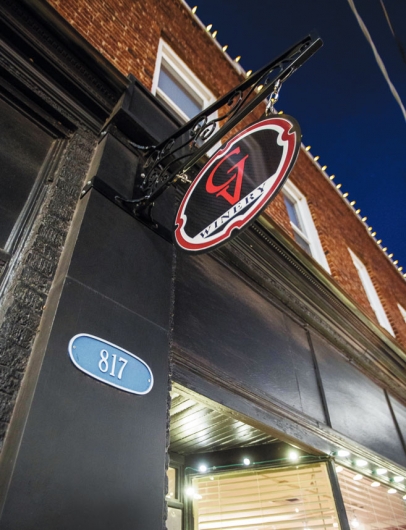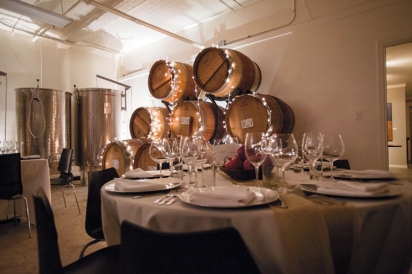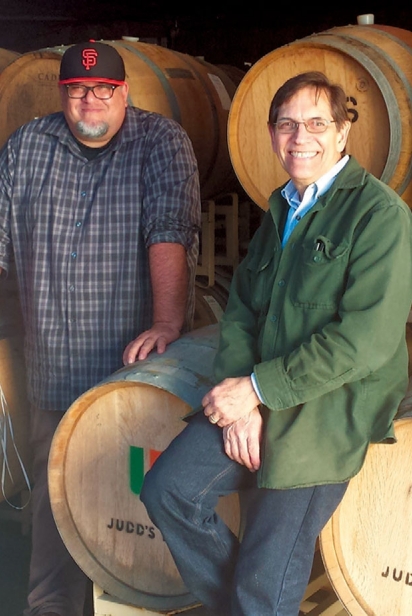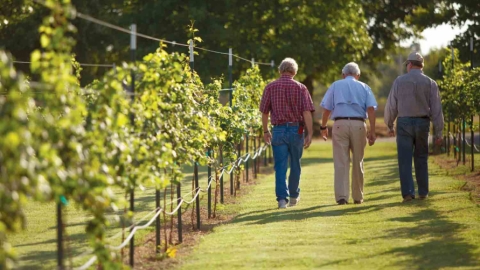Grapes of Persistence
Girouard hybrids find niche in a California vineyard
In 1962, as John Steinbeck accepted the Nobel Prize for Literature in Sweden, George Girouard scoured Oklahoma creek beds in search of the ultimate variety of red dirt wine grape. The trek of the fictional Joad family in Steinbeck’s 1939 novel The Grapes of Wrath was as arduous as the odyssey that Girouard had undertaken; fooling Mother Nature through hybridization of traditional European grapevines and wild Native American vines. Yet, unlike the Okies of the 1930s, Girouard, a retired petroleum engineer, would spend 50 years before he finally developed the prized grape hybrids. His investment of time was worth it.
—Steve Gerkin, Grapes of Wrath, a Red Dirt Reprise (This Land Press, October 2010)
The travel of Steinbeck’s Joad family showcases a mixture of undeniable perseverance and a search for destiny in a new land, California. Struggle and strife fueled their passion to be a part of a migratory community. George Girouard knew to his dying days that if he kept pursuing his hybrid research, crossing Oklahoma’s hardy but less prized red grape vines with some noble vinifera cuttings, that one day he could grow powerful Syrah-like grapes similar to those of France’s Northern Rhone Valley. After a half-century of trying, Girouard produced a stable of four capable thoroughbreds.
George’s son Chris Girouard and his wife, Jan, carried the torch, planting George’s hybrids in several locations near Tulsa. Seeking a more favorable growing climate and a group of grape farmers in the Joads’ adopted state, they located a six-generation farming family just south of Sacramento, near Clarksburg, which boasted its new official designation of an American Viticultural Area (AVA) that spans three counties, featuring dense clay and sandy loam soil, blessed by a smattering of morning fog and afternoon breezes from San Francisco Bay.
This favorable terroir, environmental growing conditions, attracted the Girouards to team up with Heringer Estates, a ranch with its own history worthy of a Steinbeck novel.
Managed by Heringer brothers Duke and Steve, the ranch blossomed to 6,000 acres by the 1980ss from the original 200 purchased in 1918 by their great-grandfather. The expectation of continued bumper crops and a large promissory note for their tomatoes from the California Climate and Agriculture Network (CalCAN) painted an optimistic picture for the family. Regrettably, the area along the Sacramento River Delta suffered devastating floods, ruining their crops and drowning the promised funding. The Heringer ranch became insolvent in a flash and they lost everything.
An investor bought them out. The transition agreement allowed Steve and Duke Heringer to manage all their former properties, and they insisted on a buy-back option for the core of their ranch, their great-grandfather’s original 200 family acres. That positioned them to regain that property. Wine grapes were becoming Napa’s cash cows and the brothers knew growing grapes could make their property profitable. They won a contract from a large wine producer to grow 100 acres of Chardonnay and later added 45 acres of Petite Sirah.
In 2002 Mike Heringer, one of Steve’s sons, returned to the family business in 2002 after completing a degree in viticulture and enology at UC Fresno. He managed the vineyard and started the Heringer Winery. At the time, many of the area’s long-term farmers grew fruit dictated by winery contracts. It was a relationship that flagged several years later, when the demand for Chardonnay tanked. Dependence on the volatile nature of the big wine houses was not a good business model. With one grape varietal occupying so much of the Heringer growing space, the brothers sought to diversify for economic protection.
While at Fresno, Mike determined the Clarksburg region could sustain many varietals. While no one was doing research or experimentation in the area, he was convinced their ranch could grow a wide range of phenomenal grapes. The confident pioneer in the AVA began a graft-over program in 2006, grafting six new varietals onto the 5C rootstock of the existing Chardonnay. Mike knew Teroldego, Tempranillo, Malbec, Barbera, Primitivo and Viognier were disease resistant, grew predictably well and were easily sustainable. The success of these six encouraged the graft-over project to the point that Chardonnay grapes occupied only 32 acres. This trend-setting vineyard also became the California home for George Girouard’s four hybrids.
In 2010, through the recommendation of a fellow wine producer, Chris Girouard approached the nurseryman of the Heringer Ranch, Gene Glazer, also a grape and wine producer in nearby Davis. Glazer had assumed the role of mentor for Mike’s graft-over conversion, teaching him the grafting technique and demonstrating a workable business model. Glazer was so enamored with Chris’s story of his father developing successful hybrids that he wanted to be a part of the process. Knowing they had the expertise and motivation to dedicate an acre of graft-over rootstocks for the four Oklahoma-developed hybrids, the Heringer group jumped at the chance to work with these unique plants.
George’s hybrids—By George, Plymouth, ValJohn and Southern Cross—have prospered under the Lodi Rules Wine Grape Sustainability Management Program. These rigorous guidelines dictate an annual inspection by a third-party auditor who assesses all the operations of the Heringer Estates vineyard as well as its economic and human resource sustainability. The hybrids’ well-being is under the direct control of Steve’s son, Stephen, a 12-year Army veteran with two Mideast tours under his belt and a penchant for military leadership that comes in handy with vineyard activities.
Stephen has learned that the four Oklahoma hybrids are extremely disease resistant and do not require fungicide treatment, no dusting or spraying. Occasionally, like all varietals, they get a boost from a little fertilizer and a light oil treatment to the leaves. An ozone-spraying regimen may be in the offing.
The Girouard vines are the slowest ripeners in the vineyard and their phenolic development—those several hundred elements of the wine that affect taste, color and mouthfeel—reaches a peak patiently. In time, the hybrids may become own-rooted plants rather than grafted solely to the Chardonnay rootstock.
Once harvested, the Girouard grapes travel the short distance to the Judd’s Hill Winery on the Silverado Trail, a mile north of Napa, past the strawberry stand. And there is no hill—pretty flat, actually. After Art Finklestein sold Whitehall Lane winery in Napa, he bought a parcel on a substantial hill in the Vaca Range along the east perimeter of the Napa AVA that overlooked Conn Valley. His young son, Judd, helped with the startup winery on the hill, kindly named Judd’s Hill.
When purveyors and clients found it dangerous to negotiate the twists and turns of the mountainous road to the winery, Art bought property on a flat section of the Silverado Trail in 2005, but maintained the elevation-inappropriate Judd’s Hill name. Judd uses his college broadcast degree to host a popular Napa radio show and is intimately involved with the blending and bottling of the winery’s beverages.
Demand for their wines grew, attracting the winemaking star of 24 years from Raymond Vineyards, Kenn Vigoda. Until New Year’s 2015, the affable and understated Vigoda has been the captain of the ship, ending his seven and a half year run with Judd’s Hill. He oversaw Judd’s wine production but also vinified for a hundred smaller customers, who utilized Judd’s reputable micro-crush facility to turn their prized fruit into great wines. After a fall crush, the winery often has over 200 open-top fermenters making precious wines.
Speaking with a writer in December 2015, as the Girouard wines perked nearby, Kenn jested that for a while he thought the Girouard hybrids would be harvested after Christmas, instead of the usual September- October crush season for most Napa-region grapes. Once in the bins, he knew they would need extra attention to reduce their naturally high malic acid—think Granny Smith apple acidity. Kenn has experience with a Muscadine grape that, if not treated properly in the winery, has acids that are much too high to be drinkable wines.
Several years ago, Jan and Chris Girouard approached Vigoda with the prospect of him solving the acid riddle of their hybrids. While there were no other non-vinifera hybrid grapes vinified in Napa, he enthusiastically took them on. Through the bacteria-stimulated procedure of malolactic fermentation, the acids were cut in half and the pH rose to a very pleasant tasting level.
Kenn Vigoda is now the winemaker emeritus, yielding the reins to longtime associate Eric Lyman. If food tastes better when prepared by the hands of a chef who laughs and puts “the love” into his cuisine, then Eric Lyman wines will make bottles smile uncontrollably. The bearded 50-year-old former Navy man with a wine degree from a Napa program is pumped about working with the Girouard hybrids. “Sometimes, something really cool happens, like working with George’s hybrids,” he said recently. “The Girouards are great to work with—a breath of fresh air.”
Together the Girouards and Eric are developing a new wine style. That seldom happens. These grapes are one-of-a-kind hybrids and there is no winemaking roadmap to guide them. They will not force them to taste like Cabernet, but want them to express themselves, providing new tasting experiences along with some familiar aromas. Their rosé shows tart cherry and raspberry notes while the easy-drinking red blend shows cherry, plum, spice and an Old-World earthiness.
It will take three to four years to learn the best winery techniques to maximize their natural character. To increase structure, this year Eric experimented fermenting with some whole clusters, stems and all. Randa Warren, Tulsa’s only Master Sommelier, assists in blending decisions.
The Girouard Hybrids have an amazing color. “They are as dark as a Charbono,” Eric exclaimed. “Makes you think you are about to have your face ripped off! But it is fruity and low tannin, like a Pinot.”
An early Saturday evening at Girouard Vines on 3rd Street in downtown Tulsa, next to Hodges Bend, provided a great opportunity for a writer and his comrades to settle in for a tasty treat of George’s hybrids. The revelers were split on the dry rosé and the fruit-forward red blend. As they headed into the night, several made a plea for a repeat tasting. Good call.










